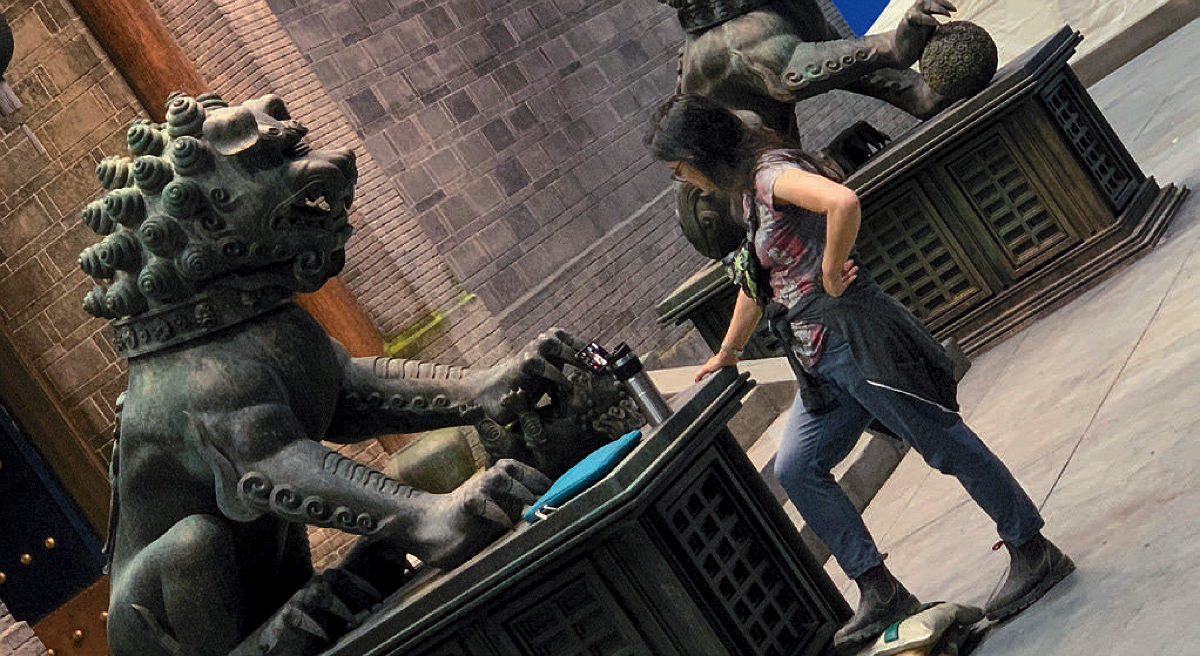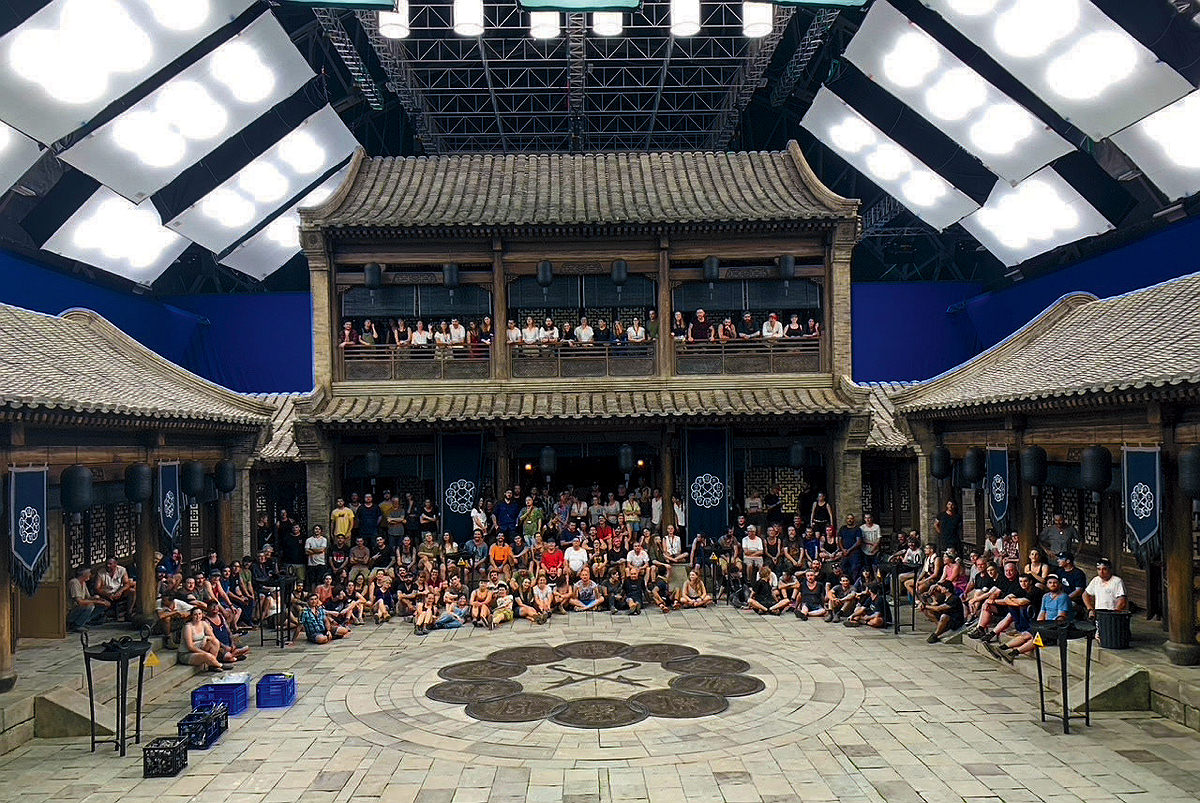Four decades ago, Blade Runner showed Sue Chan ’92 her future. She was just 12 when Ridley Scott’s sci-fi classic—heralded for its stunningly detailed futuristic Los Angeles—debuted in 1982, and Chan would go on to a career as an art director and production designer, creating visuals for films like Colossal and Marvel’s Shang-Chi and the Legend of the Ten Rings. But Scott’s film didn’t awaken in her the dream of a life in movies. “I didn’t even know someone had a job like production designer,” says Chan, who grew up working class and the only Chinese American girl in her New Jersey town, where her parents owned a restaurant. “The mechanics of moviemaking was not something I knew about, and working in the movies didn’t seem like a remote possibility.”
Instead, Chan, struck by Blade Runner’s landscape, aspired to become an architect. During high school, she took drafting courses and worked at architecture firms. Harvard had no architecture major, so Chan studied design. “That was serendipity,” she recalls, adding that she also “marinated in the theater, designing lots of sets for school productions and working at the American Repertory Theater box office.” That experience had a lasting impact. “Designing for the stage still informs how I work,” she says. “I can design something that’s exactly what’s on the page or look at themes and characters’ journeys and motifs and anchor designs to that or create an entire aesthetic world that drives the characters.”

After college, she and her then-boyfriend (now husband), Gideon Yaffe ’92, moved to San Francisco; needing a job, she worked in the marketing department of an architecture firm, but she also found an internship in video production. When that turned into a production assistant role working on videos and commercials, Chan quit her marketing job and sought opportunities in the art departments of local theaters or independent films.
Then in 1996, she landed a union job as an art department assistant on the TV series Nash Bridges. “It was bonkers,” she says. “They kept firing people, so I kept getting promoted, and after a few months I was the art director.” Chan then petitioned the larger union in Los Angeles for entry; it welcomed her in, and, seizing the opportunity, she and Yaffe moved to Los Angeles. (They now split their time between L.A. and New Haven, where Yaffe is a law professor at Yale; their daughter, Oona, matriculates at Harvard next fall after deferring admission for a year.)
Being an art director felt familiar, she says, having watched her parents run a restaurant and then worked at architecture firms. “It’s like project management for a movie set—you’re implementing ideas,” Chan says, “making the nuts and bolts happen, thinking about budgeting and foreseeing trouble.” As art director for films like Gone Girl, 300: Rise of an Empire, Shopgirl, Punch-Drunk Love, and Love & Basketball, she was designing sets, managing their construction, and helping implement the productions’ overall look.
But she wasn’t sure she’d ever get to be a production designer. One step above art directors, they work with the director and cinematographer to oversee all the creative decisions about the look of a film or series, from finding the right location or building the set to designing aliens or CGI landscapes to choosing the props and even what books will line the shelves or pots will sit on the stove of a character’s house. But beyond the creative demands, the job is competitive: production designers need an agent and must pitch their vision to the director or producer.
Chan is humble, and it’s easy to see why the competition and politics wouldn’t appeal to her (when reached for an interview, she wrote back, “It’s very flattering that you want to profile me and honestly makes me giggle because after all, who am I?”). But she is confident in her vision, knowing that even details and themes that won’t be noticed by the audience—or will be seen on camera only fleetingly—still inform the director and actors’ understanding of character and story. Chan’s debut came in 2000 with Dancing in September. Since then, she’s served as production designer for more than a dozen films and TV series, including Southern murder mystery Where the Crawdads Sing, science-fiction black comedy Colossal, and coming-of-age comedy-drama The Half of It.

Just as theater shaped her design, so did her art direction days. “I understand how the sausage is made, and my ideas are founded on knowing I can execute them,” she says, a mix of creativity and pragmatism directors find appealing. “I’ve veered toward the quirky but with heightened reality,” she says. “And I like genre-bending stuff that is a little surreal and conceptual.”
For 2020’s Shirley, she told director Josephine Decker that it felt like author Shirley Jackson’s world was centered around her writing desk, that her life organically evolved from there. So she designed the set that way, as if the desk’s roots led to everything else in the room and beyond. Decker, who also started in theater, loved the visual symbolism. It’s that level of collaboration that Chan now seeks, having reached the point where she can choose directors with compelling vision, instead of simply taking work.
She is also helping those with similar aspirations. Jasmine Cho ’14 asked for advice while still at Harvard and Chan kept in touch, later giving Cho her first shot at art directing, on The Half of It. “She was super patient and understanding,” Cho says. “She gave me guidance when I needed it without micromanaging me.”
Those traits, along with her visual sensibility, continue bringing directors to Chan’s door. Cory Finley, who directed Landscape with Invisible Hand, a 2023 sci-fi-ish movie about economic inequality but with alien overlords as the villains, had never done a movie with world-building and visual effects. He was impressed by Chan’s work on Shang-Chi—“It stood out among Marvel movies for having a personal quality and artistry”—combined with her “smaller, stranger work” on films like Shirley.
“Sue is warm and collaborative, yet she’s forthright with strong opinions,” Finley says. And she brings a storyteller’s approach to design. The main family in Landscape had been upper-middle class but fell on hard times under alien rule, so Chan gave them a home with fancy suburban bones. But then she imagined they’d had to sell their chandelier, so she rigged up a lighting fixture with a broom handle and inverted lamps tied to it. “It’s a sight gag, but it’s also em otional and character-driven,” Finley says. “She’s unafraid to be weird.”









